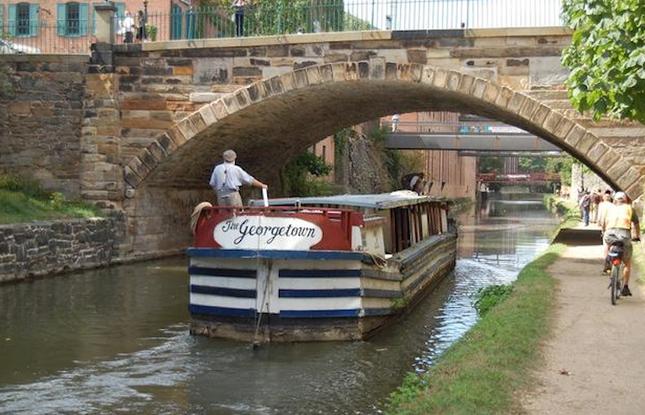Water by October, New Barge Farther Off
Almost four years ago, on Oct. 29, 2014, about 60 of Georgetown’s movers and shakers met at the home of star real estate agent and philanthropist Nancy Taylor Bubes to launch Georgetown Heritage, a nonprofit organization dedicated to protecting and promoting the history of Georgetown. The first order of business was to “raise awareness of the acute need to fund improvements to preserve the historic C&O Canal.”
That’s nonprofit PR speak for “raising around $9 million to basically fix the locks and get a new boat,” according, at the time, to Joe Sternlieb, CEO of the Georgetown Business Improvement District, which went on to house Georgetown Heritage’s staff of three or so.
The locks had not been refurbished since they were constructed in 1831 — part of George Washington’s vision that the port of Georgetown would be the start of a water road opening up the West. In 1971, President Richard Nixon created Chesapeake & Ohio Canal National Historical Park.
“For 40 years, the one-mile section of the Canal in Georgetown was a popular destination for visitors, residents, and school field trips, with mule-drawn boat tours providing an authentic, immersive experience,” wrote Alison Greenberg, Georgetown Heritage’s first executive director. But its state of disrepair became increasingly evident.
At the 2014 launch party — which included Neil Mulholland, then president and CEO of the National Park Foundation, C&O Canal Superintendent Kevin Brandt and former Mayor Tony Williams — Georgetown developer Richard Levy announced the intention to “build a coalition of residents, the National Park Service, nonprofit groups and business interests to plan for the future of the Georgetown section of the C&O Canal.”
A partnership with the National Park Service, with grant support of about $6.5 million from D.C. government, was soon announced. The first phase of the effort to restore “Georgetown’s Crown Jewel” is described in the BID’s “Georgetown 2028 15 Year Action Plan.”
In November of 2016, the NPS began restoration work at Canal Locks 3 and 4, near Thomas Jefferson and 30th Streets, just south of M Street. “Stability is a key concern,” said Joseph Reed, the civil engineer in charge. Due to the soft sediment underneath, the canal walls had moved inward almost two feet from the original 15. In addition, the locks’ 186-year-old timber foundation had become susceptible to rot.
“Now the amazing restoration work is pretty much completed,” Maggie Downing, Georgetown Heritage’s director of public programs and partnerships, told The Georgetowner last week. All the original stones — some much bigger than expected — had been removed and numbered. They are now back in place, secured by top-grade mortar. The rotting timber foundation was rebuilt with water-resistant cement that has been made to look like wood. “It’s fun to see it all now without the water to appreciate the construction of the original canal,” Downing said.
Work was to have been completed by this summer — along with a replica barge for canal rides. But there have been delays. “Some of the delays have been due to the exceptionally rainy weather this year,” said Downing. “But mainly the delay in filling and operating the lock is because of the plans by the Department of Transportation to reconstruct the 31st Street Bridge.”
The canal will contain water next month. But it won’t be completely full of water, and the new boat will not arrive, until spring or summer of 2020, according to Downing.
Georgetown Heritage is considering ways to incorporate art, entertainment, leisure and ecology into expanded educational and cultural programming along the canal. “We want to remove non-native plant species and make improvements to the foundation, lighting, access, signage and overall safety,” wrote Greenberg. “We also want to embrace ideas that celebrate what the Canal is and can be.”
The organization hired James Corner Field Operations — known for its work on New York’s High Line — and other firms to draw up preliminary design concepts for reimagining Georgetown’s one-mile towpath along the canal (viewable on the Georgetown Heritage website). The choice of Field Operations got the attention of the media, with headlines like “Making Georgetown Hip Again.”
New Georgetown Heritage board chair Jennifer Altemus said education programs, including apps and virtual reality, are being developed with the help of Lord Consulting, with Field Operations still involved. “We are beginning our next phase,” she said.
Meanwhile, Greenberg, because of family matters, has departed on good terms. “She accomplished a lot and is on to a new adventure,” Altemus said. The group is looking for a new executive director.
More to come, no doubt, as the nonprofit deals with the NPS and others to make this marvelous mile of Georgetown great again.
GEORGETOWN HERITAGE
c/o Georgetown Business Improvement District
1000 Potomac St. NW, Suite 122
Washington, D.C. 20007
info@georgetownheritage.org
202-298-9222 (BID office)
Maggie Downing
Director of Public Programs & Partnerships
Scott Walzak
Georgetown Canal Plan Project Manager
BOARD OF DIRECTORS
Chair:
Jennifer Altemus Romm, Georgetown resident
Vice Chair:
Richard Levy, The Levy Group
Treasurer:
Heather Muir Johnson, Deutsche Bank
Secretary:
Joseph Sternlieb, Georgetown Business Improvement District
Lisa Bernstein, Learn Zillion
Nancy Taylor Bubes, Washington Fine Properties
Boyden Gray, Boyden Gray & Associates
Dr. Sachiko Kuno, Halcyon
Will Langhorne, private investor
Carol Melton, Georgetown resident
Adam Metz, Georgetown resident
Pamla Moore, Citizens Association of Georgetown
Thomas L. Strickland, Wilmer Hale


